Picking the top 10 MTG Ikoria cards for Commander decks was challenging. This is undeniably a powerful set and whittling it down just wasn’t easy, but it had to be done!
This is an exciting time to be a Magic player. New sets these days are considerably above the typical power curve, and have generally come with an array of exciting designs to boot. Ikoria: Lair of Behemoths looks to be no different, and while the paper release of this set was substantially delayed, I remain very excited about the prospect of adding many of these new cards to my own decks.
The Best MTG Ikoria Cards for Commander Decks
I could easily have 15-20 honorable mentions on my list from where I had to start whittling things down, and some of those extras will be mentioned at the end of this article. For a card to make my top 10, it really had to be something special – something a variety of strategies in a given card’s colors could really take advantage of.
This means that cards that are really powerful in most individual molds (Cycling, tribal strategies, Mutate decks, etc.) aren’t going to be found here. It also means this is not going to be a comprehensive list of everything you’re going to want from Ikoria – I highly encourage you to check out the full visual spoiler to see what other gems this set has to offer you.
You also aren’t going to find any Ikoria Commander 2020 cards here – those are in a separate post.
Cards are not going to be posted in a particular order – every one of my selections are powerhouses in their own right.
Shark Typhoon
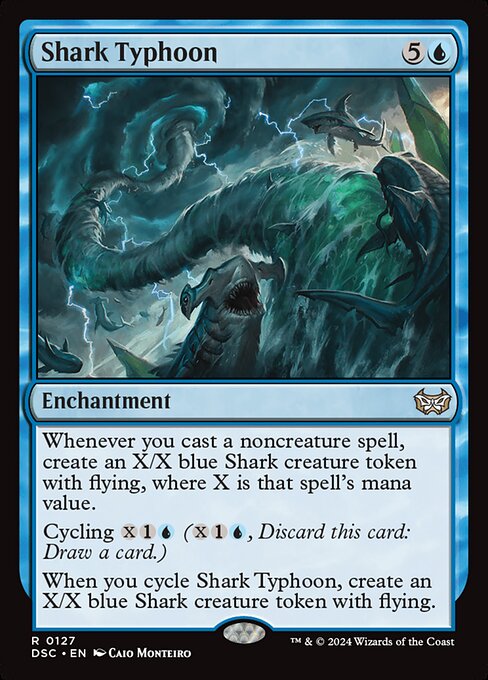
Players who have been around a while, after making the obligatory Sharknado reference that I guarantee someone in Wizards’ R&D team is extremely proud of (I know I would be), probably found themselves thinking, “Hey, isn’t this a cross between Metallurgic Summonings and Decree of Justice?” It absolutely is, and the fact that it is mono-Blue makes it extremely splashable.
6 mana is a pretty big ask for an enchantment that does nothing when it hits the table, but the incremental value it generates simply for playing a normal game of Magic is incredible. The sharks that are generated also fly (hello nightmare fuel), meaning Shark Typhoon also sets what could be a VERY fast shot clock for opponents without an air presence.
And as if that was not enough, Shark Typhoon also works on ANY noncreature spell, allowing it to serve as an alternate win condition in a variety of enchantment, instant, sorcery, artifact, and planeswalker strategies.
Oh, and if you draw it too early or are trying to duck counterspells, you also have the option of cycling it away for a card AND a creature. At instant speed. Because the card just wasn’t good enough as written.
Fiend Artisan
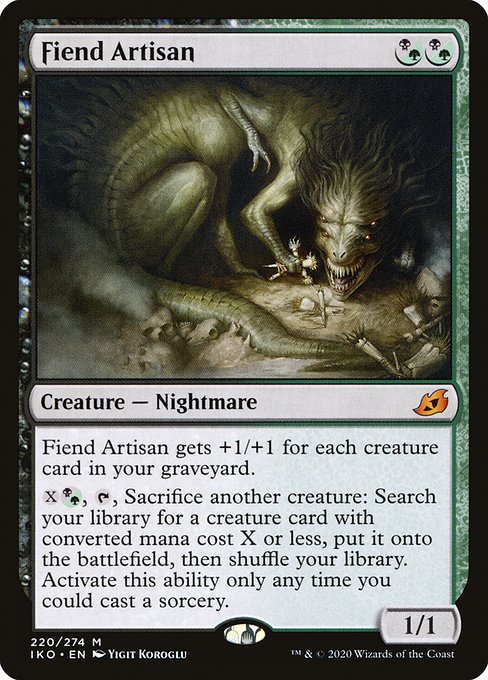
Speaking of cards that were born from smashing two really good cards together, Fiend Artisan is the offspring of Tarmogoyf and Birthing Pod. Tarmogoyf never really got there in Commander, but it is or has been a powerhouse creature in nearly any other format it was legal in due to its ability to get absurd power boosts for virtually zero extra effort.
Birthing Pod is actually banned in the Modern format, and has been known to do some fairly disgusting things at Commander tables to boot. Fiend Artisan only gets a power boost from creatures in your graveyard, and it is a little less splashable since black is part of its color identity in addition to green. It’s also slower than Birthing Pod since you can’t use its ability the turn it comes into play without giving it haste.
Unlike Birthing Pod, however, your ability to search is not limited incrementally. That “X” in the cost of its ability changes everything. If you don’t answer this card, an innocuous Eternal Witness or commander can become an impactful card like Craterhoof Behemoth, Blightsteel Colossus, or Avacyn, Angel of Hope…that you can’t counter with a traditional counterspell.
Even playing somewhat more fairly, the ability to search for less expensive utility creatures is no joke, and if for some reason you aren’t using its ability on your turn, Fiend Artisan is probably still going to be a sizable threat as an attacker or blocker.
Rielle, the Everwise
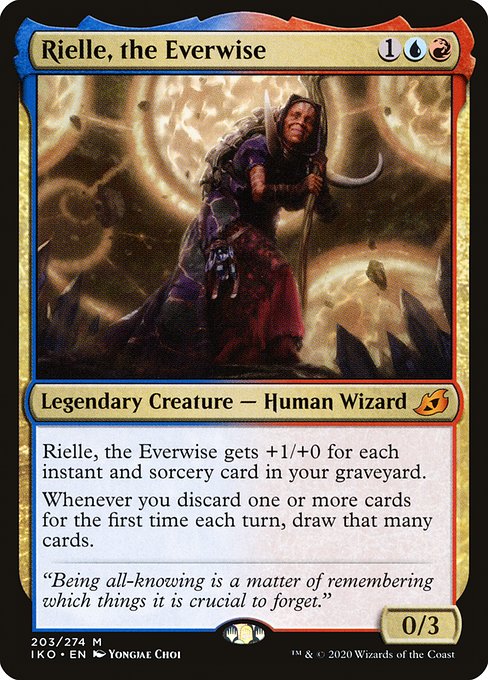
This was one of the first cards that dropped my jaw when it was previewed. Enigma Drake and Crackling Drake were my bread and butter for a long time in Standard when I played Magic: The Gathering Arena on a regular basis. I can tell you from experience that this power boost is no joke in a deck dedicated to maximizing it with Rielle at the helm. But what if you come up against someone like me, who has Relic of Progenitus, Rest in Peace, and/or Bojuka Bog waiting for you?
I mean, Rielle‘s other ability is good, but it isn’t like red and blue have access to cards like Faithless Looting, Wheel of Fortune, Frantic Search, Windfall, or a host of other similar effects.

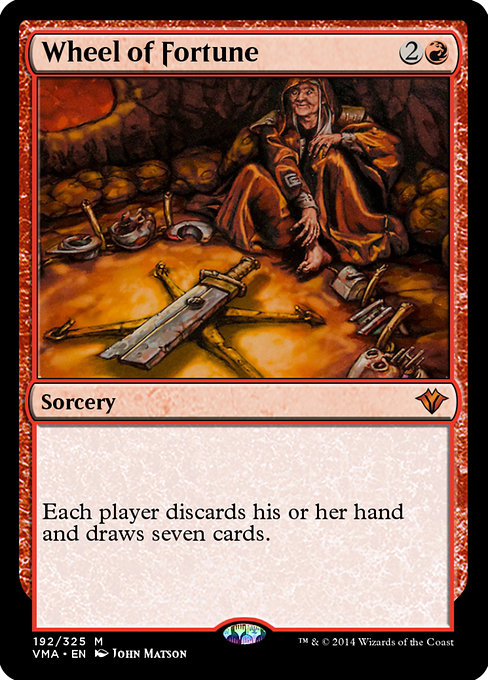

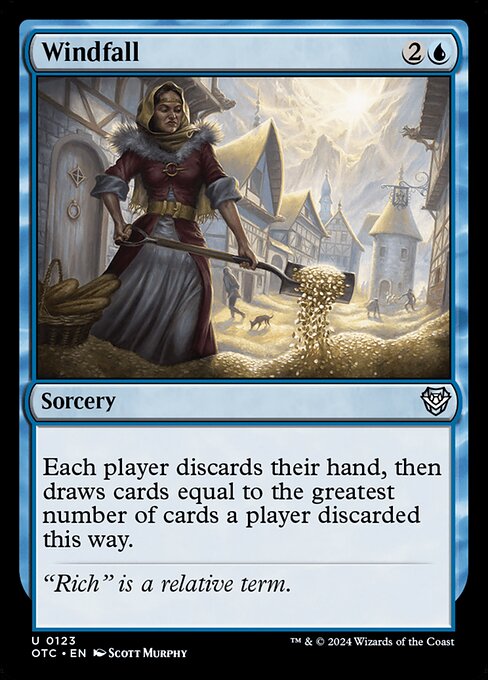
Oh, right.
The ability to draw extra cards when discarding them should excite combo players and value aficionados everywhere. Cards like the ones I listed earlier already see substantial play in Commander, so even sneaking Rielle into your 99 for some incidental value often represents a low opportunity cost that can offer substantial gain in the form of raw card advantage.
I mean, who isn’t living their best life when choosing what the best 7 cards are in a hand of 9-14 at the end of a turn? Bonus points if Nekusar, the Mindrazer, Leyline of Anticipation, or Narset, Parter of Veils are tagging along for the ride.
Lurrus of the Dream-Den
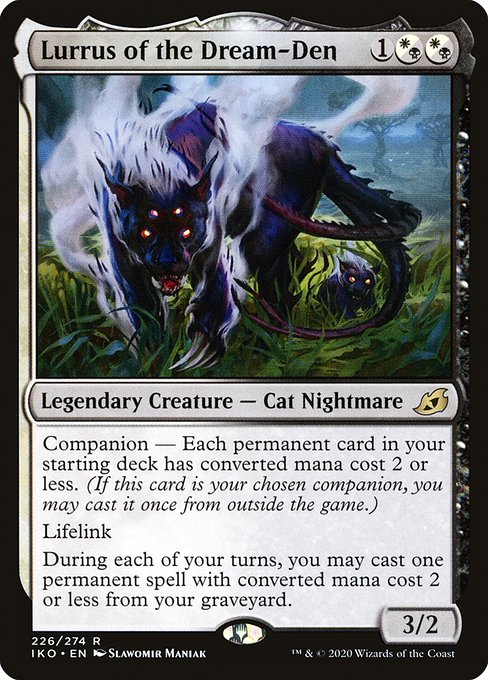
We’ve finally hit the first Companion card of this discussion, and…wow. There is a LOT to unpack here. Let’s start by talking about Lurrus of the Dream-Den as a Companion. The deck building restriction only applies to permanents, meaning you can do as you please with your instants and your sorceries. You’re still able to play the best mana rocks and permanents with “X” in their mana cost (as X=0 when in the deck).
Since decks also already exist in the format that revolve around creatures with a converted mana cost (CMC) of 2 or less, Lurrus has a niche already carved out for it to boot. Having access to an extra card at the start of every game looks a little innocuous, but it is more powerful than it will appear at first glance.
Lurrus as a Commander is going to look pretty similar as an experience when compared to Lurrus as a Companion, but with the very notable difference of being able to play particularly powerful permanents with a converted mana cost that is greater than 2. The ability to recast destroyed Sol Rings, protective creatures like Dauntless Bodyguard, and even removal spells like Journey to Nowhere is not to be taken lightly, and with a CMC of 3, you’ll have to get rid of Lurrus several times before Commander tax makes it less viable to cast.
Lurrus as a card in your deck is also extremely solid. It can be recurred through effects like Sun Titan and Sevinne’s Reclamation, is easy to tutor for with access to black in its color identity, and is going to be very easy to justify fitting into a variety of strategies that use black and white. There are very few places where it is going to be a bad card, and even if you lose access to your graveyard, it is still an efficient creature with lifelink at its worst.
Zirda, the Dawnwaker

Zirda, the Dawnwaker is the other Companion on this list, but while Lurrus represents somewhat fair Magic, Zirda‘s primary uses are going to be considerably more degenerate. I foresee access as a Companion and as a Commander usually being prioritized over a slot in your 99.
Why is this, you ask? The Command and Companion zones are always available resources when starting a game, and while Zirda has two abilities, consistent access to the first will be key for getting where you’re trying to go – infinite. Reducing activated ability costs, even if just down to 1, represents easy routes to unlimited mana through Basalt Monolith and Grim Monolith. You can then easily dump your infinite mana into your X spell or mana sink of choice (Comet Storm, Staff of Domination, etc.) to win the game or lock down the board.
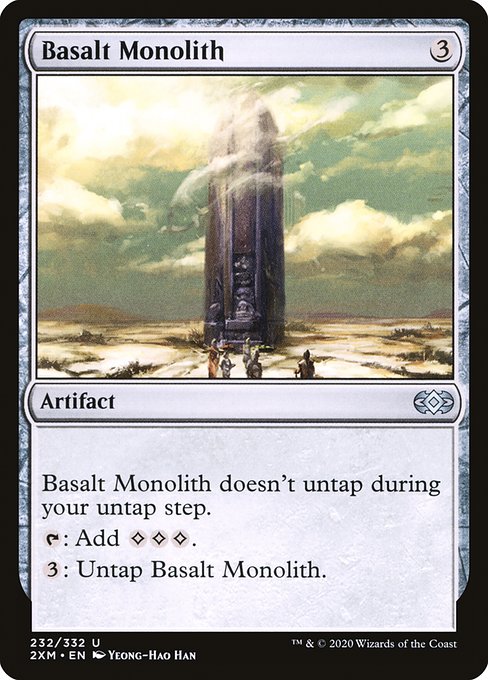
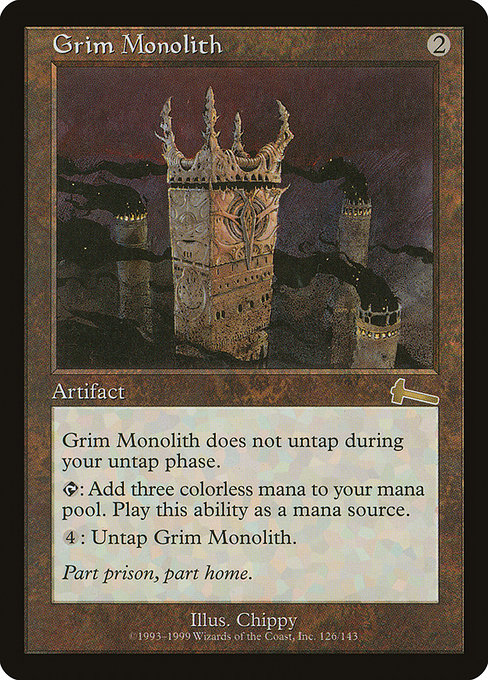
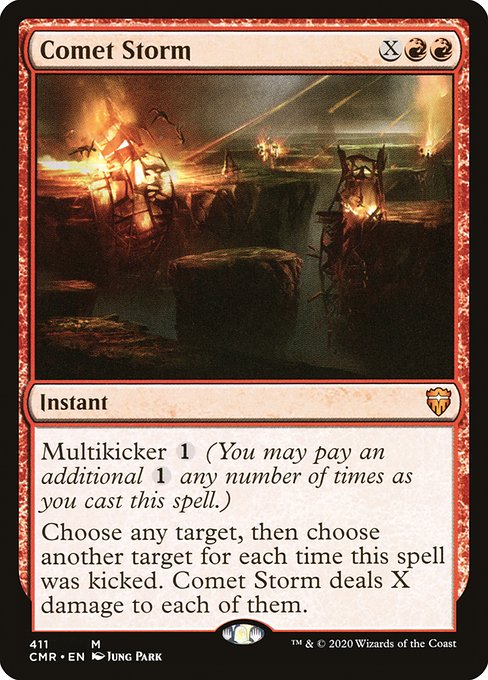
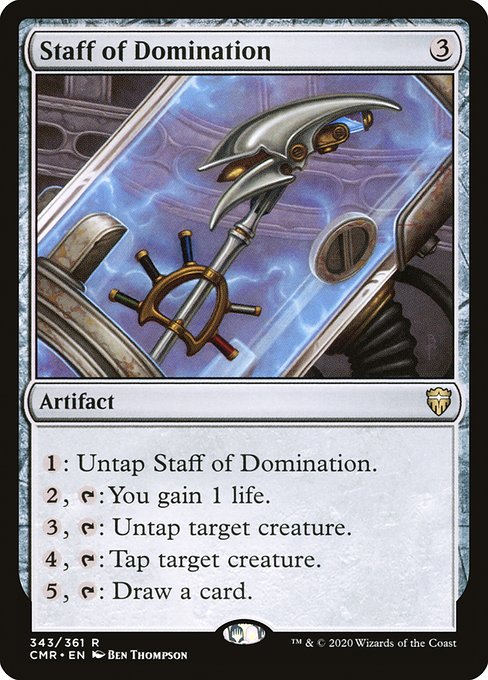
None of these combo pieces are hindered by Zirda‘s Companion restriction, and you have ample access to tutors, drawpower, and recursion between red and white. I guess it’s nice to see a Boros strategy that doesn’t rely on playing creatures and attacking, but the lack of hoops to jump through for winning the game as early as turns 3-5 is going to stop being cute very quickly.
That said, there are also a variety of strategies that will be happy to welcome Zirda as another copy of Heartstone. Some of these decks will aim for different infinite loops, while others simply thrive on getting extra uses of activated abilities.
You won’t come across Zirda as often in these capacities, but I fully expect it to crop up from time to time.
I know I’ve only discussed Zirda‘s first ability up to this point, but I honestly do not have much to say about the second one. It’s a nice extra, but one that I don’t expect to ever see activated. It simply is not the reason you’re playing this card, and if for some reason you’re considering it as a way to close games, there are better options that more thoroughly break through opposing defenses.
Mythos of Brokkos
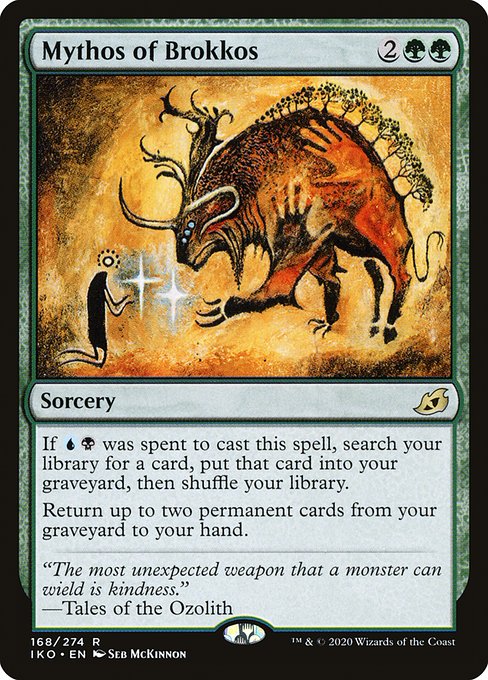
A green card that is secretly a gold card, Mythos of Brokkos is not the only impressive member of Ikoria’s Mythos cycle – but it is the one that delivers the greatest combination of value and versatility. For 4 mana, you get the effect of Entomb and 2 copies of Nature’s Spiral – allowing you to set up for some pretty powerful plays.
Entomb is a classic enabler of strategies that revolve around resurrecting cards from your graveyard, but it can also be used to set up cards with strong effects that trigger from the graveyard like Genesis, Life From the Loam, and Vengeful Pharaoh.
Nature’s Spiral doesn’t see a lot of play as it is a less flexible version of Regrowth, but it is still able to retrieve a wide variety of cards. Most importantly, because effects on a card are completed in the order they are printed, you can retrieve the card you place into your graveyard with Mythos of Brokkos. A slightly restricted Demonic Tutor paired with a Nature’s Spiral is an incredibly solid effect at 4 CMC, and even if you aren’t able to get the correct colors of mana to pay for the Entomb effect, you’re still breaking even in terms of your benefit to mana ratio.
When the worst way you can play a card is still considered good value, you’ve got a definite winner on your hands.
Eerie Ultimatum
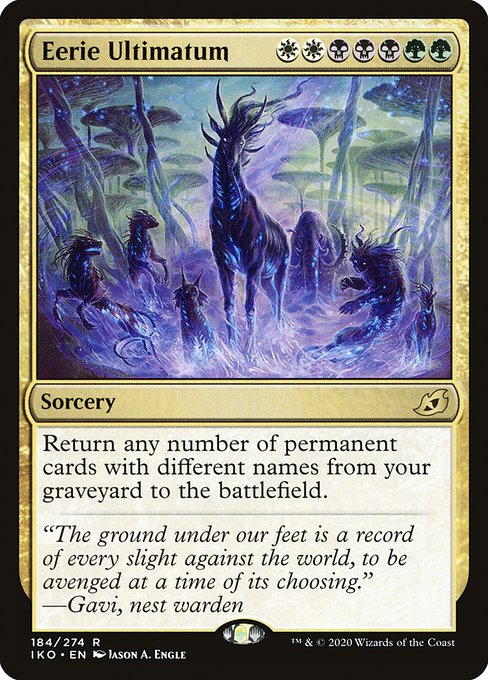
Primevals’ Glorious Rebirth is already a pretty powerful card, but it only works on legendary permanents and has an activation requirement you have to jump through. In exchange for Eerie Ultimatum‘s steep color requirements, you get to throw all restrictions on activation and permanents you’re allowed to retrieve out the window.
Fetchlands like Windswept Heath, creatures, artifacts, enchantments, planeswalkers – a who’s who of all the cards in the graveyard your opponents spent the game dealing with get to come back for a reunion tour all at once.
7 mana is also a steal for this effect – cards like Rise of the Dark Realms cost 9 for good reason. Just make sure to steer clear of graveyard hate and exile effects beforehand – having Eerie Ultimatum stuck in your hand with an empty graveyard will feel as bad as winning outright with it feels good.
Emergent Ultimatum
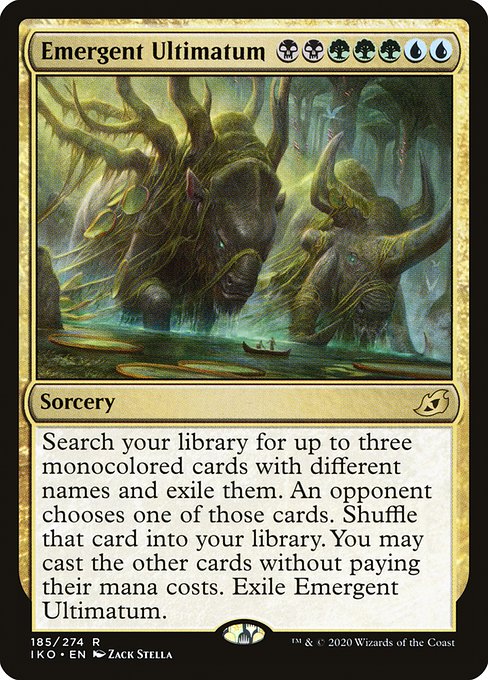
Speaking of extremely pushed 7 mana spells, Emergent Ultimatum is what happens when you want to give your opponents a Fact or Fiction effect that could cost them the game. Assuming even a moderately progressed game and board state, being handed a choice between Craterhoof Behemoth, Rise of the Dark Realms, and River’s Rebuke, knowing two of them are about to resolve, is going to leave you feeling pretty helpless.
And this is one of the nicer interactions I could think of – choices between Tooth and Nail, Kiki-Jiki, Mirror Breaker, and Pestermite exist on the meaner end of the spectrum, and they will just end the game outright. Thank goodness it exiles itself after resolving – Eternal Witness would make Emergent Ultimatum more insufferable if it could be looped across multiple turns. It’s already a one card combo that will only get better with time (Time Stretch, Expropriate, and Nexus of Fate), and that’s more than enough.
Whirlwind of Thought

I’m not usually a fan of nonland cards that do nothing when they hit the table, but Whirlwind of Thought represents an inexorable source of card advantage in many strategies that will win you the game if allowed to stick.
Storm decks, Jeskai commanders like Narset, Enlightened Master that revolve around noncreature spells, and even builds that just run fewer creatures than average will all be very interested in this effect because it doesn’t have any limits.
You just play cards, get rewarded with card draw, then use your new cards to get still more cards until you run out of mana. Rinse and repeat until you bury your opponents with an excess of resources. Getting upside for simply playing the game has historically led to some very powerful cards (see our previous discussion regarding Tarmogoyf), and I’ll be very surprised if this ends up as an exception to the rule.
The Triomes
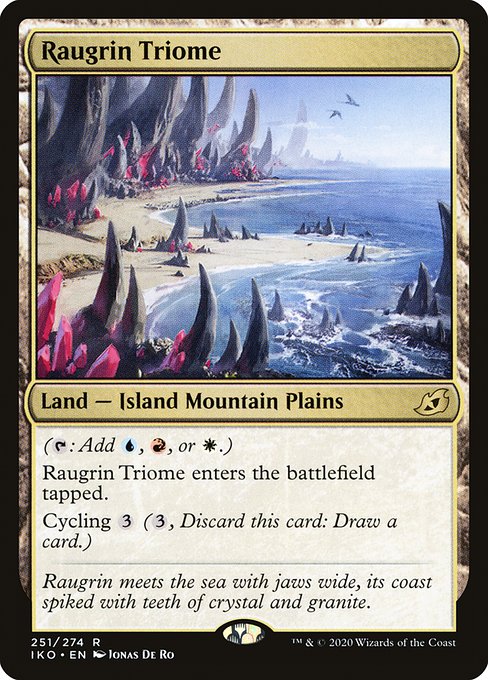
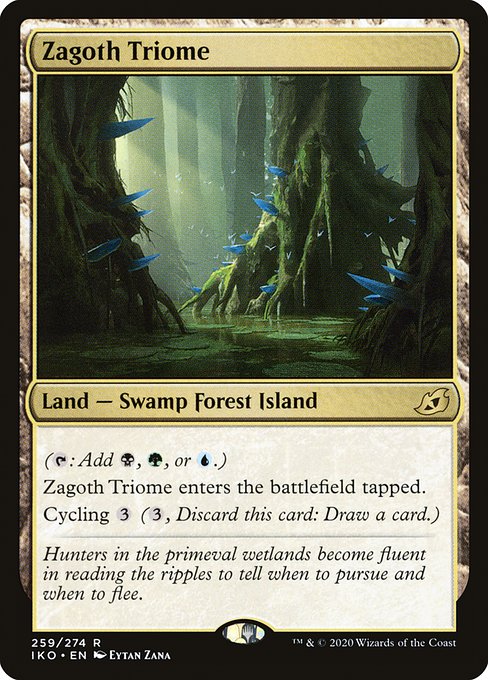
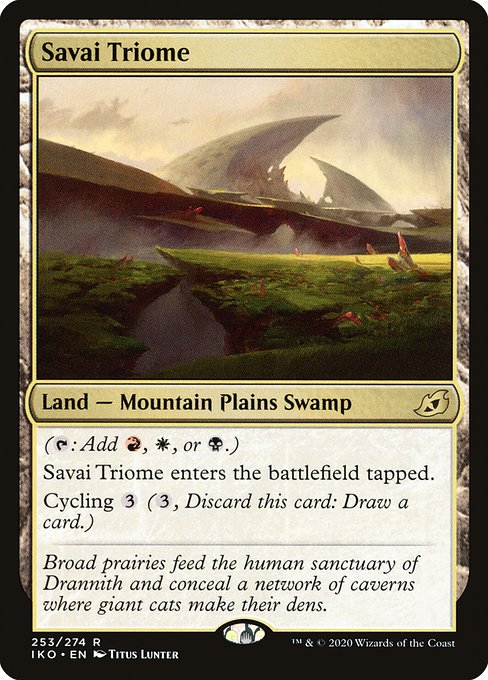
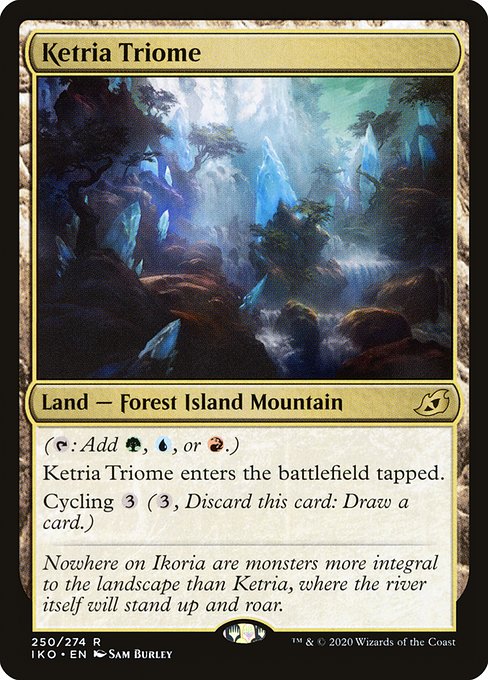
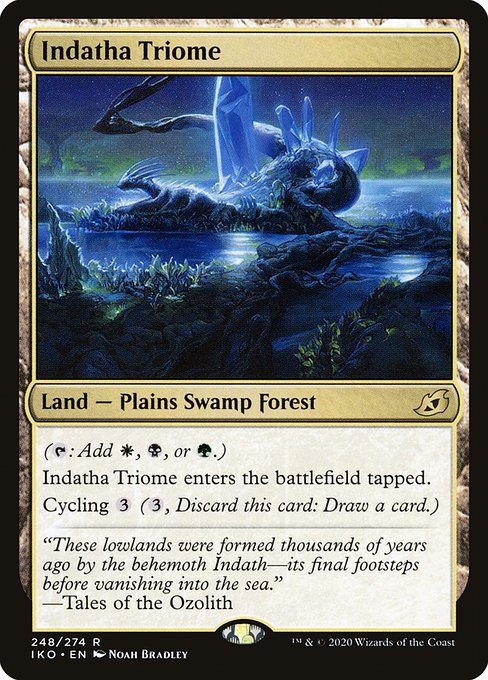
I know this is 5 cards, but if I talk about one, I’ll end up going over all of them. Inherently, the Triomes all represent things we’ve seen before. Lands with cycling have been around for over 20 years, lands that enter the battlefield tapped and tap for 3 colors of mana have been around for over 10, and nonbasic lands with basic land types have been around since Alpha.
These lands combine all of these characteristics and are the first lands to contain more than two basic land types, giving us something we haven’t seen before.
But even that isn’t entirely true; Amonkhet gave us a very similar cycle of dual lands like Canyon Slough as recently as 2017, and these lands weren’t as well received as counterparts like Temple Garden or Cinder Glade. What is it exactly that’s going to make Triomes so much better?
The short answer: mana flexibility.
Decks that run 3 or more colors of mana often find themselves in a difficult position when trying to make sure they have consistent access to every type and combination they need.
That difficulty only becomes a greater burden as you add more colors, but by using lands with basic land types, you can mitigate this problem by making use of helpers like Polluted Delta, Skyshroud Claim, and Knight of the White Orchid to find them and put them onto the battlefield quickly.
The original dual lands like Underground Sea are prized because they give you these benefits AND enter the battlefield untapped. While enough time and money can help you add these to your collection, spending hundreds of dollars on a few rare cards simply isn’t viable for many – especially if your deck runs all five colors and can use all 10.
The Triomes present an affordable alternative that is capable of bridging this gap by delivering additional flexibility over original duals at the cost of a little speed. Here’s a quick breakdown of some key strengths that set this cycle of lands apart from others:
- Each Triome can be searched for by 9 different fetchlands like Flooded Strand (Dual lands with basic land types can only be found by 7, and lands like Arcane Sanctum can’t be found by any)
- Cards like Nature’s Lore can effectively ramp you into 3 colors of mana instead of 2
- Triomes are going to be readily available and can be reprinted (Original dual lands are part of the Reserved List, so no new copies will ever be printed as long as it stands)
- Cycling is very relevant when you are flooded with mana and would rather trade your land for another draw to either close the game or recover from an unfavorable board state
If you have a complete collection of lands to choose from, the Triomes will probably only see intermittent use in your 3 or 4 color decks. If not, I’d consider this cycle of lands a very worthwhile investment for any deck running 3 or more of the appropriate colors. They may never come in untapped, but that downside often isn’t actually a hurdle if you carefully time when you play a mana ramp spell or fetchland.
And if enemy wedges aren’t what your deck is looking for, Streets of New Capenna released the allied shard versions in 2022!
Best Ikoria Cards for Commander Decks: Honorable Mentions
Many of these can stand up to the cards I listed earlier (and can be mixed and matched for a truly great deck)
- Kinnan, Bonder Prodigy
- Vivien, Monsters’ Advocate
- Illuna, Apex of Wishes (Great value for building around Ikoria’s Mutate mechanic)
- Extinction Event
- Winota, Joiner of Forces
- Gemrazer (An ideal creature for Mutate decks seeking artifact and enchantment removal)
- Obosh, the Preypiercer
- Lukka, Coppercoat Outcast (A niche, but repeatable way to cheat big creatures into play)
- Yorion, Sky Nomad
- Kogla, the Titan Ape (Niche, but surprisingly difficult for certain decks to deal with)
- General’s Enforcer
- Death’s Oasis
- Drannith Magistrate
These honorable mentions are just a few of the cards worth adding to your MTG collection, and you can easily build or support a variety of commander decks with them. Plus, a larger collection means more cards you can choose from for your deck, which in turn makes you better prepared against lots of decks you’re likely to face!
Don’t Forget the other Ikoria: Lair of Behemoths Cards!
Big beasts, wedge support cards, the companion mechanic – the best Ikoria: Lair of Behemoths cards are not only cool, but also have the potential to be both powerful and impactful in a variety of Commander games. Whether you’re just starting out or are tuning an old deck you’ve played for years, there something for everyone in this set.
10 Best Ikoria Cards: Final Thoughts on Ikoria Cards for the Commander Format
And that’s the list! There are a lot of powerful Ikoria cards I didn’t cover today, and if there’s one I missed, you can actually come tell me directly through our Patreon Discord! You’ll also get access to a variety of awesome perks and behind the scenes info about Assorted Meeples, and occasionally a few extra surprises we don’t advertise.
Plus, we have an awesome community that you’ll fit right in with; some of us have the occasional untap.in commander night or go all out with a SpellTable phone setup to play with our real cards! I’ve also covered the Ikoria Commander 2020 cream of the crop, so make sure to give it a read to make the most of Ikoria’s awesome cards while building your deck!
Braden is a founder of Assorted Meeples and has been a gamer & writer with a vivid imagination all his life. Don’t believe us? Check out his excitement when meeting Goosebumps author R.L. Stine as a kid! An avid Magic: The Gathering spellslinger for over 15 years, you can always convince him to shuffle up for a game (or three!) of Commander.
